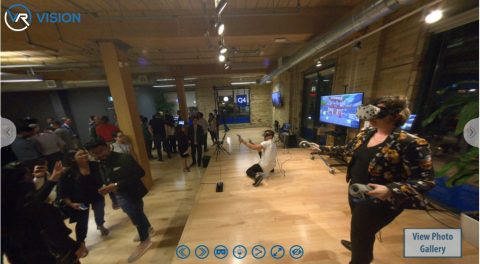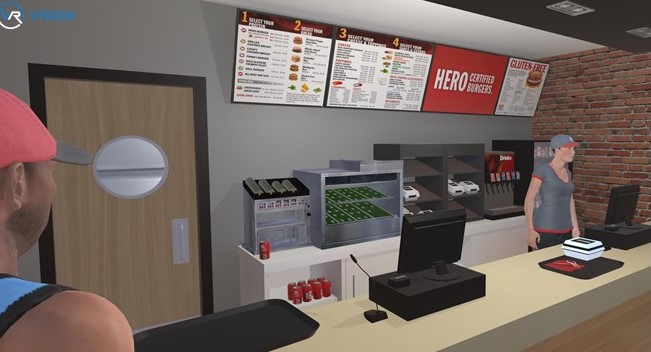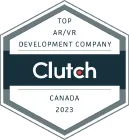One of the hottest trends in the world of corporate events is the use of virtual reality. VR is set to be the most exciting method of presenting brands, products, ideas, and key information. Being that virtual reality is a relatively new technology, its uses are always evolving, and at a rapid rate.
Adoption of VR technology at events is changing the way presenters interact with their audience. VR allows presenters to put their audience in a virtual 3D environment that reflects the essence of the message they are attempting to deliver.
Virtual reality and augmented reality (AR), can be implemented in any event or presentation for an enhanced marketing effect that delivers a true wow-factor experience to every audience. We have prepared a guide for businesses to use when looking to incorporate virtual reality at their next event, trade show or conference. So without further ado here is a definitive guide to using virtual reality technology at your next event.
The Types of Virtual Reality Best Suited to Events
By now, you must have been living under a rock if you haven’t heard of Virtual reality. However, not as many people are aware of augmented reality. The critical differences between these two technologies are easy to identify, and both offer tremendous value to any event or presentation.
The Difference Between Virtual Reality and Augmented Reality
VR is an entirely simulated environment created by computer-generated images featuring life-like situations for users. The immersive experience offered by virtual reality engages your visual and auditory senses, pulling the user into a virtual world that looks, and sounds like a genuine experience.
Specific VR simulations can be liked to movement patterns as well. Video games and theme park rides use virtual reality simulators coupled with physical stimulants such as roller coasters. Virtual reality simulators are effective because they cover the eyes, offering a seamless, wide-angle experience that has no dead spots, or frame around the screen. The result is astounding, virtual environments look, sound, and feel like the genuine article.
Favorite uses for VR at events include video games, experiential marketing, training simulations, and live entertainment shows.
Augmented Reality (AR)
Unlike the virtual environment simulated by VR, augmented reality blends the virtual world with real-life situations. The best examples of AR are the filters on Snapchat. Those cute puppy noses and ears that you add to your posts is augmented reality technology at work.
The core difference between AR and VR comes in the fact that augmented reality does not wholly construct a virtual environment in the same manner that VR does, AR enhances reality. The rise of apps like Snapchat and video games like Pokémon Go have put augmented reality technology in the palms of millions of users all around the world.
Back in April of 2012, Coachella featured a full-length concert with deceased rap superstar, Tupac Shakur. The event held at the Coachella was the brainchild of Jim Steinmeyer. The image of Tupac performing on stage left the audience spellbound. Social media feeds erupted with misinformed viewers swearing that it was the dead rapper, risen from the grave. The Tupac holographic performance was the world’s first look at what was possible with the technology and a raging success for Steinmeyer.
Virtual and Augmented Reality Tools for Events – How Do My Attendees Experience VR and AR?
There are two methods of distributing VR and AR content. Desktops are the most popular option for VR. Desktop systems like the Oculus Rift & HTC Vive offer the best quality images and resolution for VR environments. In recent years, companies like Google and PlayStation have developed harness devices that allow users to plug their mobile device into a VR simulation platform.
Mobile technology is still some ways behind desktop applications regarding image quality. However, mobile VR and AR tech is accelerating at break-neck speed. It won’t be long before mobile VR and AR platforms are the gold standard. The public has widely adopted mobile VR and AR technology due to the low-cost barriers to entry.
The 2 Methods of creating VR Content
Programmers of virtual reality environments use two approaches to develop VR content. The first method uses two or three different cameras to record a panoramic view of a real-world setting. Engineers will then “stitch” the photos taken by the cameras together to form a 3D panoramic environment that looks exactly like the real thing.
The second method of creating VR content uses computer-generated images (CGI). In this scenario, engineers construct an entirely artificial environment, relying on computer power. This method is popular for video game platforms. Design teams can create fictional settings such as the surface of a planet in another solar system.
8 Ways to Use Virtual Reality Technology at Your Next Event
Amaze your attendees at your next event by implementing VR technology with your presentation. VR tech is the cutting edge of marketing in 2018. Virtual simulations engage audiences and force them to interact with your event. Traditional displays that rely on a speaker and slides may lose their audience if the material becomes stale.
VR presentations trap the attendees in a virtual world that they can’t escape. You’ll benefit from their undivided attention as they stare at the screen of their device, mesmerized by the virtual world on offer to their eyes and ears. Use VR to build your brand by engaging your audience and providing an out-of-this-world experience they’ll never forget. Here are 8 ways VR can benefit your next event.
- A Virtual Experience
Volvo is the best case example of VR used by a brand to promote a product. When the Nordic car manufacturer released their XC90 model, they invited interested buyers to attend a virtual product presentation.
Volvo hooked all of their attendees up to Google Cardboard mobile VR devices. The simulator ran a program where all attendees got to experience driving in the cab of the XC90. The campaign was a smashing success, and the XC90 became one of the best-selling models of the Volvo range.
The app is still available on the Volvo site. Users with Google cardboard can download the app for free and try out the simulation with no charge. Volvo marketing has suggested that the success of the app will carry over to other Volvo models and they have plans to release virtual drives for all of their cars.
- Event Marketing
Attending conferences and events usually comes with a hefty entrance fee. Many people interested in attending need a bit of encouragement to push them into participating. What if you could use VR and AR to market your event and increase ticket sales?
Following the Volvo VR concept, marketers can take their event into the virtual realm to prospect for event attendees. Imagine the power of being able to show your clients around the venue, into the VIP area, and backstage to meet the speakers! Pump up your audience and your ticket sales with a VR experience.
- Demonstrate Your Products
VR works for all types of products, not just Volvos. Digitally immerse your audience in your product and brand with a VR experience that will increase conversion and sales. Allowing a prospect to handle your product using VR or AR virtually, is as good as placing the real thing in their hands. Research suggests that value perception in prospects increases by up to 33% when adding AR to marketing campaigns, and VR tools can increase buyer’s certainty by up to 135%.
Increase your prospect engagement, boost your sales, and market your product effectively with the virtual reality revolution.
- Virtual Attendance

There is no longer any need for physical showrooms, or keeping stock on hand to show potential customers. VR and AR allow marketers to reach their core audience at any time and any place where a buyer expresses interest. Virtual presentations save companies time, money, and resources by making their presentations “on-demand” for their prospects and customers.
With a virtual reality event, there’s no limit to the number of seats in an event location. It’s possible to present to millions of people at a time from any area that offers an internet connection. VR events and presentations are the directions in which the future of marketing is moving, don’t be left behind.
- Erase the Lines Between Reality and Fantasy and Reality
With VR, it’s possible to distort reality and add any elements you would like to the virtual environment. A great example of this technology in action came from the San Diego comic convention.
The AHS Fearless Virtual Reality Experience achieved this feat by inviting fans to become part of the show. Fans donned VR headsets and headphones, taking fans back through time to the most memorable moments of the show.
More and more simulations are blending the line between what is physical reality and what is virtual. We are seeing companies incorporate wind, sound, scents, and other forms of haptic feedback in order to bring the user that extra layer of immersion that they wouldn’t have felt otherwise.
- Virtual Venue Surveys

Link your VR to past events and allow the user to walk through the exhibition in real-time using VR technology. The prospect can feel the vibe and intensity of the room without ever leaving their armchair at home.
This tech provides marketers with an indispensable tool to reach prospects, providing an immersive experience that beats any YouTube clip, or event brochure. The ability to have a virtual 360 walkthrough or a tour of a venue that can be web-ready and brought into virtual reality is priceless and is being used more and more by not only real estate companies but architects, builders, hospitals, sports venues, and government facilities.
- Use VR for Training

VR can use the same principles for training as well. Students and employees can benefit from the technology. Walmart is the first retailer to incorporate VR into their employee training programs. The company states that VR helps management train employees faster and improves the quality of the training.
Walmart training centers link the VR headset to an external screen that allows the trainer to guide the new employees through the training experience. You can apply the same training tactics to your event program and teach your attendees new skills in real time.
- Create a WOW Experience for Your Audience

Coca-Cola is well-known for its creative marketing campaigns around the Christmas period. The company introduced a WOW experience to their customers with the introduction of Santa’s VR sleigh ride. Coke took thousands of cheering customers on a virtual sleigh ride through the North Pole, via the Oculus Rift platform. The trip dodged polar bears, swept over highways, and flew through towns on a joyride that attendees would never forget.
Apply this strategy to your next event. Work with a talented VR team to develop a WOW customer experience that thinks outside of the box. VR is a blend of information and entertainment that offers a robust platform for marketing and promotion. Sit down with your team and come up with creative ideas for your company “WOW.”
Wrapping Up
Use the power of VR and AR technology to make your virtual world a reality at your next event or presentation. Virtual reality is here to stay, and you can expect to see further advances in this technology in the years and decades to come. The possibilities for VR and AR applications are endless and thrilling.
Boost the power of your message to your audience by using the latest marketing technology available. VR and AR allow you to think big and realize your wildest marketing dreams for your brand or product.
Have you tried virtual reality, or augmented reality at an event before? Let us know about your experience with the technology in the comments below! And if you are looking for an all-encompassing solution for your business with virtual or augmented reality, get in touch with us today to see how VR Vision can help bring your ideas to life!









